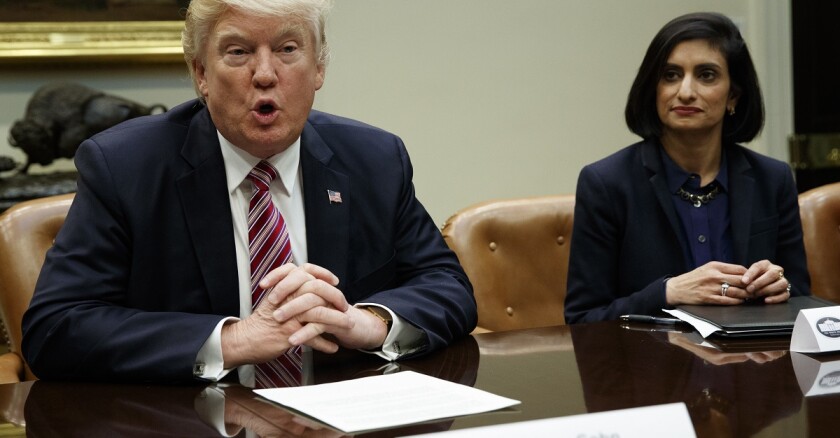In October, the Centers for Medicare and Medicaid Services (CMS) encouraged states to apply for new "State Relief and Empowerment Waivers," which would allow them to sell health insurance plans that duck Obamacare regulations and use federal subsidies to make them more affordable.
The Affordable Care Act (ACA), President Barack Obama's signature health law, requires health plans to cover "essential health benefits," such as preexisting conditions, mental health care and maternity care. The relief waivers would let people buy plans, with subsidies, that don't include that coverage.
When CMS Administrator Seema Verma announced the waivers, she told reporters it was one way for state lawmakers to "get out from under the onerous rules under Obamacare."
Almost seven months later, not one state has applied.
Political and Legal Concerns
The silence from states is partially politically motivated. Congressional Republicans' attempt to repeal Obamacare hurt them in the midterm election. The ACA's protections have proven to be popular among voters across the political spectrum. So even states run by opponents of the ACA aren’t clamoring to roll them back."That concern [over preexisting conditions] was considered to be a big draw in people going to the polls last fall," says Sabrina Corlette, research professor at Georgetown University's Center for Health Insurance Reforms.
There’s also reason to believe that the policy wouldn’t hold up in court. When submitting a health waiver, states have to prove that it will meet several standards: provide coverage that is at least as comprehensive and affordable as other plans in the marketplace; cover a comparable amount of residents; and not add to the federal deficit.
What About Association Health Plans?
During the first few years of Obamacare, health premiums experienced double-digit increases in many states -- 34 percent was the average hike from 2016 to 2017. Insurers didn't expect so many sick and costly people to sign up, and they partially attribute the rise in prices to not setting appropriate rates to begin with.But after a couple years of trial and error, along with state intervention, "the marketplaces are fairly stable at the moment," says Corlette.
In an effort to lower premiums, the Trump administration has already loosened some ACA provisions. Last year, CMS rolled out new rules that allow for greater use of short-term plans (which were highly regulated during the Obama administration) and make it easier for insurers to sell association health plans, which don’t have to comply with the ACA.
While some states have banned short-term health plans and some took the association health plan changes to court, others have embraced those new options.
Why would states accept association health plans but not apply for relief waivers when the result in both cases is coverage that doesn't have to comply with the ACA?
One reason might be that short-term and association health plans don't require state lawmakers to go through the waiver process -- an insurer or group just has to create them. Submitting a health waiver to the federal government is a big undertaking. State officials would have to collect a significant amount of data, get legislative approval, allow the policy to sit for a public comment period and write an extensive draft of what the policy would look like.
"A state is likely thinking, 'Are we going to have to do all of the work that a waiver process requires, only to end up in court?'" Corlette says. (In March, a judge sided with the states challenging the association health plan changes. The federal government hasn't indicated yet if it will appeal.)
Furthermore, the relief waiver is just a guidance -- it didn’t go through the formal rulemaking process that would have codified the policy into law.
'Uncharted Territory'
Eight states have been granted waivers to try something new with their health-care marketplaces. All but one of them were for reinsurance programs.Reinsurance waivers let states (with some federal assistance) pick up the tab for the sickest and costliest residents. This usually spurs insurance companies to reduce their premiums.
"If I'm a state and I’m trying to move forward to get more people covered, I’m going to look at what’s already worked. Reinsurance is one thing, and improving subsidies, those are proven to be more productive," says Sarah Lueck, senior policy analyst at the Center on Budget and Policy Priorities.
But the relief waivers, she says, are "a bit of uncharted terrority."









